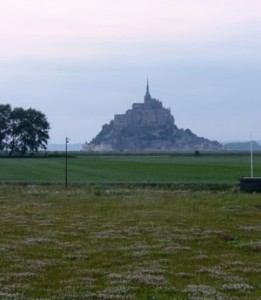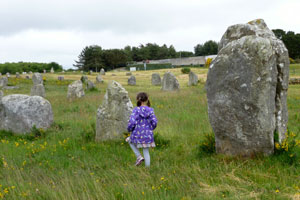A full-bearded immigration officer looks curiously at two toppling hotel carts of luggage for three people.
Philippe, eight-year-old Lolo and I are staying in France until the end of August, we explain to the officer at the airport in Brittany. From here, we head to our home in Antibes.
Antibes? he says with a vague smile. He turns halfway toward the neighbouring border agent to share the joke. Antibes, ça n’est pas la France!
Antibes isn’t France.
Philippe and I laugh, too – who doesn’t laugh at an immigration officer’s joke? – and proceed through the gates.
We’ve touched down in Brittany for a few days before continuing south to our summer hometown. We’ve been returning there, to the French Riviera, on and off for eight years now. One time when life allowed it, we actually managed to live in Antibes for a full year.
But this summer, before hitting the shores of the Med, we’re here in Brittany. Seeing the place is part of our bigger project of visiting more of France each summer than just its feted Côte d’Azur.

Geographically speaking, it’s tough to find a corner of France that’s further from Antibes. If our home in the Côte d’Azur is the extreme southeast of France, Brittany is the extreme west of the northwest. From the words of our immigration officer, though, it sounds as though the sentiment goes further than pure geography.
This area’s big draw (which is technically just over the border in Normandy) is Mont St Michel, a jagged outcrop of rock surrounded by water and topped by an abbey having roots back to the 8th century. By some index, the place ranks as the most visited tourist site in France outside Paris.
Brittany has its features, too. It is the birthplace of Jacques Cartier, founder of Canada, and a virtual place of pilgrimage for Quebeckers like Philippe. The region is celebrated, too, for its iconic crêpes and its menhirs, smaller but far more prolific Stonehenges scattered through parts of the countryside.
Lolo, meanwhile, doesn’t want to visit Brittany. She wants to go to France.
But we ARE in France, Philippe and I tell her.
She means the REAL France. She wants to go to the REAL France. To Antibes. The Côte d’Azur.

Our daughter obviously didn’t hear the bearded immigration officer. But in some ways, he was right. Even if Brittany and the Côte d’Azur share the same national borders, the two areas are poles apart. The architecture here in Brittany is hardly stucco with red-tiled roofs. It’s Norway’s gables-meets-England’s Tudor period. The population eats dinner at 7pm, not halfway to midnight. Butter is served in a bucket. And truth be told, the weather is not at all Côte d’Azur. For this morning’s swim aerobics class in Brittany’s sea, participants wore wet suits.
If Brittany is the real France, I reason, then the Côte d’Azur can hardly be teaching us foreigners about the true French culture.
Lolo wants to know how many hours before we are in France. She corrects herself. In Antibes, she means.

We work on her math skills, starting with a few multiples of 24.
As our family whittles away the hours in Brittany, though, we start to recognize aspects of France that actually unify its extremities. Lolo mentions the pointy white road signs with black writing.
How many hours until we’re in Antibes NOW?
A frilly, white Petit Train for tourists runs up and down the streets of St Malo and Carnac, just like in our Antibes – and in Monaco, Nice and Cannes.
We track down the tourist information office in Carnac. Fermeture exceptionnelle on Tuesday, the day we’re standing outside its locked doors. No other explanation. Yes, Brittany is definitely part of the overarching land that we know as France.
How many hours now?

One afternoon we three climb to the top of Mont St Michel, the focus of our visit. The ticket office is closed. Workers are on strike because the price of parking (in the public lot that’s situated on the plains some three kilometers from the island) has gone up from EUR 8.50 to EUR 12.00.
But no worries! The striking ticket agents are in solidarity with us, the over-paying public! As we’ve already paid the extortionate parking charges, and we’ve suffered the interminable shuttle buses to reach the base of the island, the employees have swung wide the gates. We can roam around the abbey’s vast domain for free today. the r on in!
This – in one of the country’s most popular tourist sites. Surely we are nowhere BUT France.
Now how many hours until we’re in France? Lolo asks. She gets her mistake, but she’s no longer using the facts. She’s on strike.
Fortunately for her, the answer finally requires little math. We leave Brittany tomorrow morning at 11:00 a.m.
Except that we don’t actually leave. France’s air traffic controllers are on strike because the French airport heads are discussing the possibility that there might possibly be future discussions with some people in Europe. Possible discussions about the abominable subject of unification.

And, the headlines warn us, don’t even consider taking the train instead. There are no trains. The drivers are on strike. The national railway company has some EUR 36 billion of debt, and counting, and the government has finally announced that it needs to deal with it. It’s the perfect reason to go on strike for not just one or two, but three days.
But eventually, one day late, Philippe, Lolo and I finally fly to France. The real France. We apologise to the bagagiste about our sky-high luggage carts.
Pas de problem! she says. For this length of stay, she expects two toppling hotel trolleys – each.
Et voilà! There’s Christelle, our favourite Côte d’Azur taxi driver, behind the glass doors waiting for us. Her strawberry-blonde hair glows in the abundant sunlight. She’s absolutely radiant in her skinny white jeans, sparkly electric blue and white top, and electric blue, open-toed, slender-heeled spikes. Those shoes would be unwieldy even without trying to drive a taxi.

Thirteen centimeters! she confirms about the heels, with pride. That’s over five inches.
France, the only France, finally has welcomed us.

